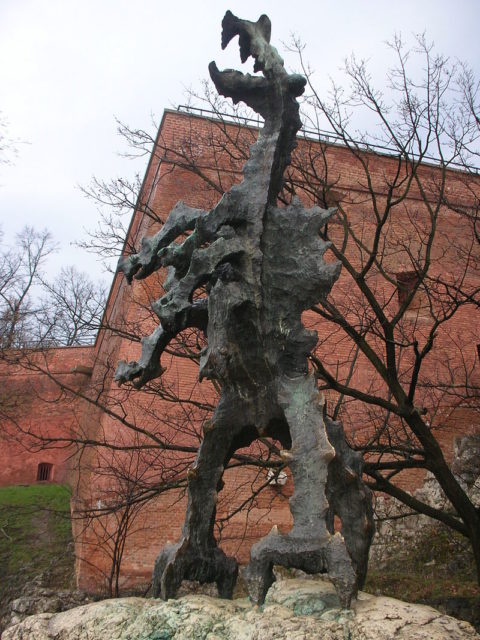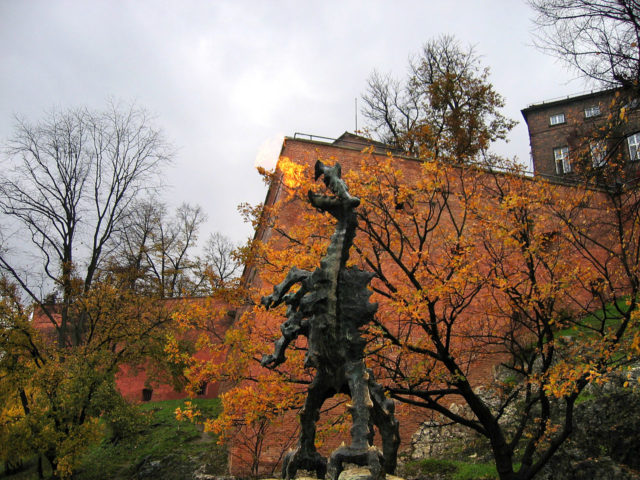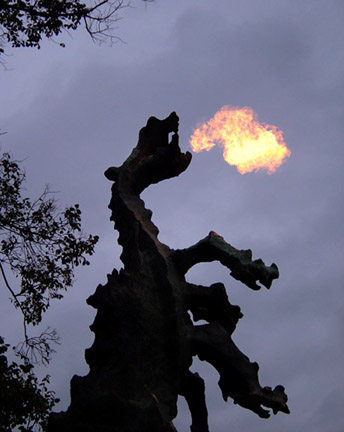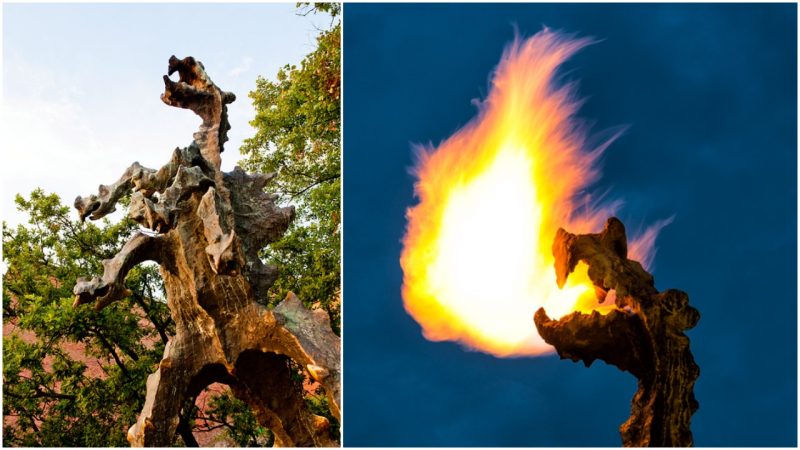Dragons play a prominent part in the folklore narratives of the Middle Ages. In many instances, they were drawn on maps to chart unexplored areas of possibly dangerous places. Fast forward in time and dragons are still present around the world. Besides appearing in a great number of movies, they are also depicted on sculptures, from England to Japan and from Scotland to Vietnam. Many great cities take pride in having a splendid sculpture of a dragon.
In Europe, one of the best places to go hunting dragon sculpture is in Poland. If you have visited Kraków, you know dragons can be seen everywhere. But one of the most eye-catching representations of the dragon is the Wawel Dragon Statue, close to the Wawel Hill. Thanks to an intervention in the monument design, this sculpture can nowadays even breath fire.

In earlier designs of the Wawel Dragon sculpture, there was a water fountain, but eventually this feature was changed to a more authentic fire-breathing one. The sculpture can blow fire by making use of natural gas as fuel. The latest update of this feature also allows people to trigger the flame by sending an SMS from their mobile. It should go without mention that the service is a huge attraction and it brings a flavor of folklore to the modern-day landscapes of the city.
The piece was done by the Polish sculptor Bronislaw Chromy, a renowned name in the arts of Poland who passed away in 2017. Even though he completed the Wawel Dragon in 1969, the date of the installation that is commonly mentioned in many sources is 1972. The sculptor himself once noted that he had the statue completed in 1969, but it was concealed from the public eye until three years later.

Measuring 20 feet and made of bronze, the piece is languishing in the shadows of the Wawel Castle. The story related to the dragon in question is interesting. The creature’s name is Wawel Dragon but also Smok Wawelski, and it is popular in Polish mythology and folklore. According to the legend, the Wawel Dragon inhabited a cave on the Wawel Hill, very close to the banks of Vistula river, and it lived during the reign of Kraków’s mythical founder, King Krakus.
Notorious in its nature, the dragon often terrorized local villages, feasting on the villagers’ daughters and pillaging people’s houses. In order to fix the issue, Krakus announced that he would marry Wanda, his dear daughter, to any courageous man who would find the strength to beat the dragon. The challenge was accepted by a cunning cobbler whose name went as Skuba.
As the story continues, Skuba outwitted the dragon by placing a lamb that had sulphur in its belly close to the cave where the dragon lived. The beast didn’t wait too long to devour the bait, and soon after, its thirst became unbearable. In desperation, the dragon drank excessive amounts of water from the Vistula, so much that he exploded. King Krakus then stood true to his word and married Wanda to Skuba.

To make the lore complete, there is a strange assembly of giant bones chained up next to the entrance of Wawel Cathedral. Legend has it that these were Wawel’s bones; however, in reality, the bones should belong to an animal.
Reportedly, the bones had never been subjected to analysis, so people are uncertain what is the true nature of the relics, but they are still credited with having protective properties. It is a common belief that they protected the city of Kraków from being battered during World War Two as were most other major Polish cities.
Nevertheless, Kraków is not the only city across Europe where the figure of a dragon has been taken as a symbol of a city. The dragon rises in the Slovenian capital of Ljubljana, and most thankfully at the city-famed Dragon Bridge, which is also adorned with mesmerizing dragon statues. The popular Ljubljana dragons are older than Krakow’s Wawel, and they are known for being a splendid example of Art Nouveau architecture. The bridge was completed by 1901, and part of its original decoration featured parapet lamps that were powered by gas.
